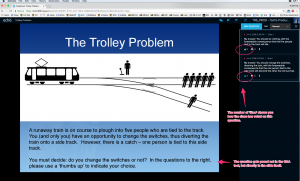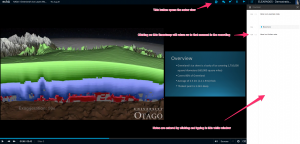Using the Q&A tool in Otago Capture to poll the class
There is a great deal of interest around the University in the prospect of a comprehensive “classroom response system”. A classroom response system allows a lecturer or tutor to seek feedback and answers from a class of students. For example, a lecturer may put a multi-choice question on a slide during her lecture, and call upon the entire class to electronically select an answer. After that, an aggregation of how the class responded can be displayed on the slide.
While the University does currently offer sets of hardware ‘clickers’ for this purpose, this system is beginning to show its age. Teaching staff often express to the eLearning team how useful a more up-to-date system would be, which relies on software (on students’ own phones, tablets, and laptops) rather than hardware. We hope to offer a fully-featured classroom response solution in the future.
In the meantime, I want to share a simple idea designed to get some crude classroom response functionality out of our existing Otago Capture system.
This idea requires the lecturer to upload her slideshow for the lecture to Otago Capture in advance. Some instructions for this preliminary step can be found in our Quick Start Guide.
The Q&A tool in Otago Capture allows staff (and students) to submit typed questions pertaining to a given slide. Once a question has been published, any users of the section who view that slide, can look at the question, and choose to give that question a ‘thumbs up’. The total number of users who have given that question a thumbs up, is displayed below. While the Q&A tool is typically used to ask questions, there is no reason why it can’t be used to display a selection of prospective answers to a question.
This means that a lecturer can pose a question to the class within one of the slides of her slideshow, and direct the students to answer that question by endorsing one of two prospective answers which she has previously submitted as “questions” using the Q&A tool. Click on the below screenshot to see an example of how this might look in practice.

At last the infamous Trolley Problem from first year ethics can be used to demonstrate something useful.
There are a few pitfalls to this technique. Firstly, the Q&A tool must be turned on in the settings for the section (as it is by default). Secondly, there is nothing to stop students from publishing additional questions which may appear alongside the prospective answers, thus muddying the waters. Thirdly, there is nothing to stop students giving a thumbs up to all the prospective answers. Fourthly, the thumbs up appear in real time, so a student may see how the class vote is unfolding before she selects her own answer.
While recognising the limitations of this technique, I think it may nonetheless prove useful for some teachers. Please feel free to drop us a line if you incorporate this in your teaching, or if you want to share any other thoughts about classroom response!
Otago Capture Ready for 2018
ITS eLearning is excited to announce the arrival of the new and improved Otago Capture. Several papers in Summer School are already using the new system. The Otago Capture Administration Application will be available to use on Thursday 15th of February for 2018 papers. The application has been updated to work with the new version of Otago Capture.
This version of Otago Capture is now available and includes significant advantages over the previous version. Some key improvements are:
- In Lecture: Capture can be used to deliver your lecture, with students following along in real time, asking questions, and sending notifications if they find anything confusing.
- Student Note Taking: Students can now take notes directly within Capture when watching the recording (or when following along with the slides in the Lecture Theatre). These notes are tied to the context they were taken (i.e. the time of the video, or the specific slide), and can be revisited for effective revision.
- Improved Analytics: Analytics are now more specific. Instructors can see how many students followed along during a given lecture, watched the recordings, took notes, and so on.
- Technical improvements: This version of Otago Capture does not use the outdated Flash software, instead it uses HTML5 to display the recordings and slides, which allows for full compatibility with modern browsers, and superior security.
- Mobile App: A mobile app for watching the recordings, and taking notes. Instructors can also upload videos using this app.
You can find more information on the Otago Capture Help Site.
eLearning will be holding demonstrations of the new system on the 16th and 19th of February, more information can be found on our Seminars Page. If you would like us to give a demonstration for your department please contact us at its.elearning@otago.ac.nz or contact the ITS Service Desk.
IT Training will also be running two training sessions in February for Otago Capture, you can sign up for these from the IT Training site.
Notes and bookmarks within Otago Capture
The new Otago Capture system will bring students the ability to make notes and annotations within the same system they use to view the lecture recordings.
Obviously, it has always been possible for students to take notes on their lectures. The advantage of the new note taking tools in Otago Capture is that they link these notes in a very direct and straightforward way to the course content they pertain to.
Each annotation is taken alongside a moment in the recording, and a timestamp for that moment is created alongside the note. When a student revisits her notes later, she can click on the accompanying timestamp for a given annotation, to go back to the precise moment in the recording that gave rise to her comment.
If no particular comment is required, the system also allows for users to create bookmarks, which highlight key segments for later revisiting. Both comments and bookmarks are illustrated in the screenshot below.
These notes and annotations are easily collated and accessed from the Study Guide tab. Within this tab, a student can view her notes for any given lecture.
Student notes are private and can only be viewed by the student who took them. However, for analytics purposes, Course Co-ordinators will be able to see the number of words of notes a given student has taken (while not being able to access the content of those notes).
Since the entire point of this system is to group student notes alongside course content, these tools function best when used onscreen, within the Otago Capture application. However, if a hard copy or archival format is required, it is also possible for students to export their notes and bookmarks in a .txt format. This exported format does not include the course content, but does include all the work that the student has created, along with written (non-clickable) timestamps to provide the context.


